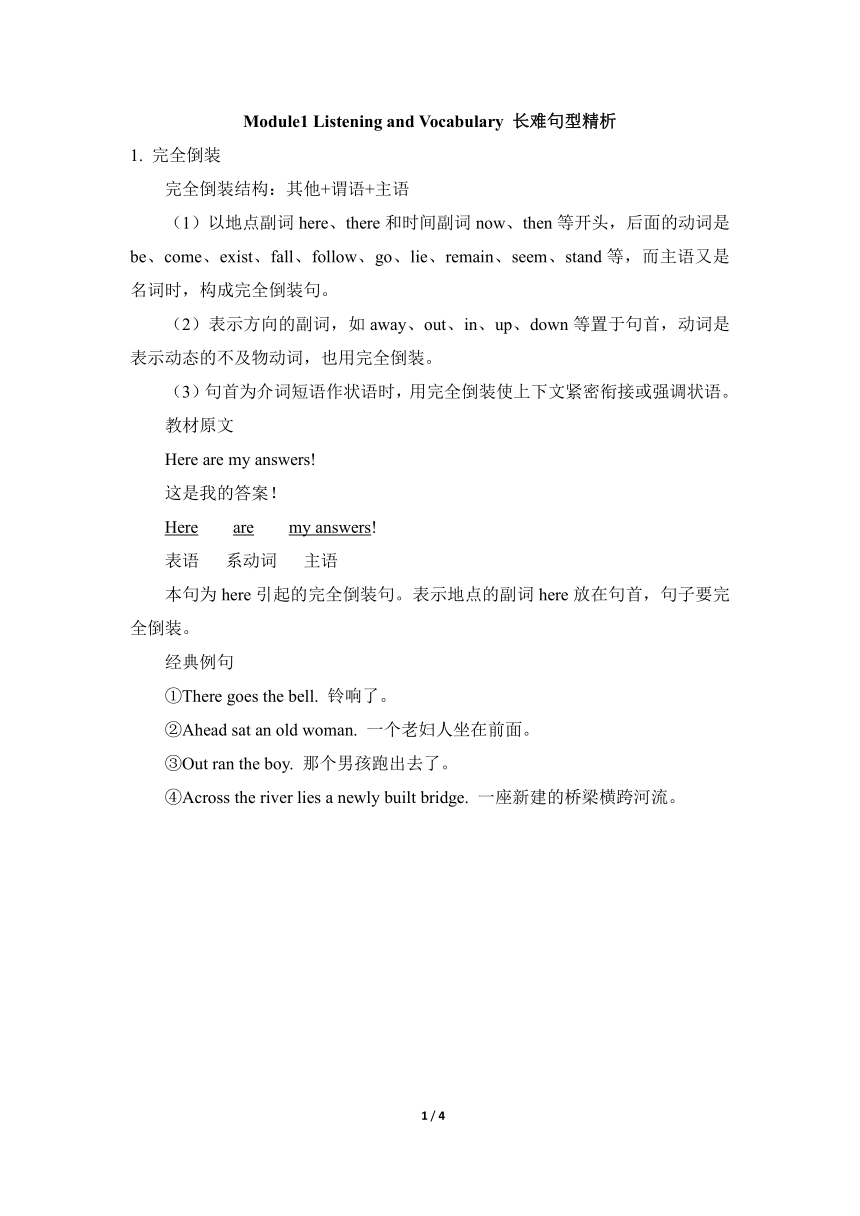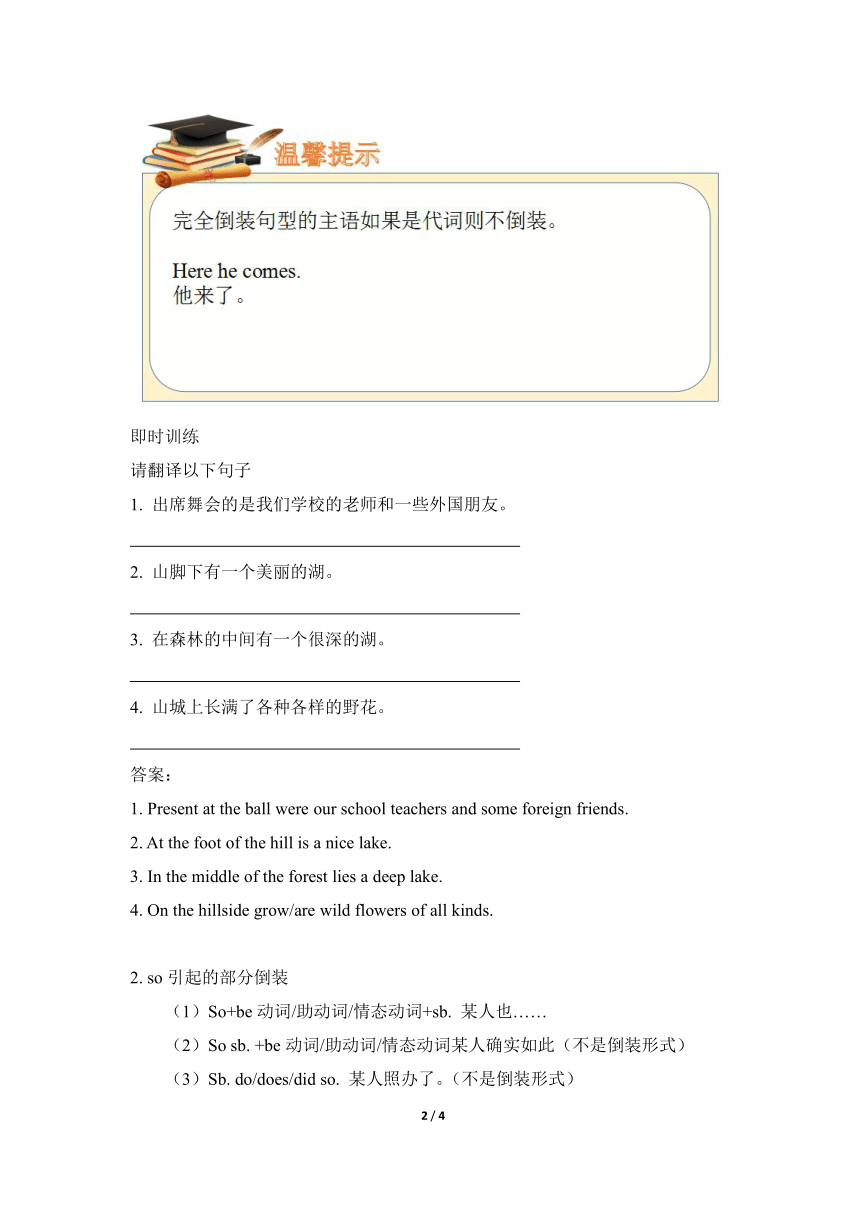外研版 必修1 Module1 My First Day at Senior High Listening and Vocabulary长难句型精析学案
文档属性
| 名称 | 外研版 必修1 Module1 My First Day at Senior High Listening and Vocabulary长难句型精析学案 |  | |
| 格式 | doc | ||
| 文件大小 | 182.0KB | ||
| 资源类型 | 教案 | ||
| 版本资源 | 外研版 | ||
| 科目 | 英语 | ||
| 更新时间 | 2023-02-12 11:12:13 | ||
图片预览


文档简介
Module1 Listening and Vocabulary 长难句型精析
1. 完全倒装
完全倒装结构:其他+谓语+主语
(1)以地点副词here、there和时间副词now、then等开头,后面的动词是be、come、exist、fall、follow、go、lie、remain、seem、stand等,而主语又是名词时,构成完全倒装句。
(2)表示方向的副词,如away、out、in、up、down等置于句首,动词是表示动态的不及物动词,也用完全倒装。
(3)句首为介词短语作状语时,用完全倒装使上下文紧密衔接或强调状语。
教材原文
Here are my answers!
这是我的答案!
Here are my answers!
表语 系动词 主语
本句为here引起的完全倒装句。表示地点的副词here放在句首,句子要完全倒装。
经典例句
①There goes the bell. 铃响了。
②Ahead sat an old woman. 一个老妇人坐在前面。
③Out ran the boy. 那个男孩跑出去了。
④Across the river lies a newly built bridge. 一座新建的桥梁横跨河流。
即时训练
请翻译以下句子
1. 出席舞会的是我们学校的老师和一些外国朋友。
2. 山脚下有一个美丽的湖。
3. 在森林的中间有一个很深的湖。
4. 山城上长满了各种各样的野花。
答案:
1. Present at the ball were our school teachers and some foreign friends.
2. At the foot of the hill is a nice lake.
3. In the middle of the forest lies a deep lake.
4. On the hillside grow/are wild flowers of all kinds.
2. so引起的部分倒装
(1)So+be动词/助动词/情态动词+sb. 某人也……
(2)So sb. +be动词/助动词/情态动词某人确实如此(不是倒装形式)
(3)Sb. do/does/did so. 某人照办了。(不是倒装形式)
教材原文
So have I. 我也是。
So have I.
So 助动词 主语
此句为部分倒装结构,表示前面所说的情况也适合后者,so用于肯定句,neither和nor用于否定句。
经典例句
①He can sing English songs, and so can I. 他会唱英文歌,我也会。
②You are an engineer, and so is she. 你是一名工程师,她也是一名工程师。
③He didn't see the film and neither did I. 他没有看这部电影,我也没有看。
④-He is an excellent musician. 他是一位优秀的音乐家。
-So he is. 他的确是。
3. Would you mind. . .
(1)Would/Do you mind doing sth. 你介意做某事吗
(2)Do you mind if sb. do/does sth. 你介意某人做某事吗
(3)Would you mind if sb. did sth. 你介意某人做某事吗
(4)Would you mind sb. /sb. 's doing sth. 你介意某人做某事吗
教材原文
Would you mind answering the questions for me 你介意回答我几个问题吗
Would you mind. . . 用来委婉地提出请求,意为“请你……好吗 ”或“你介意……吗?”
经典例句
①Would you mind my using your new car 你介意我用一下你的新车吗
②Would you mind if I played with you 你介意我和你一起玩吗
③Do you mind if I open the window 你介意我打开窗户吗?
9 / 9
1. 完全倒装
完全倒装结构:其他+谓语+主语
(1)以地点副词here、there和时间副词now、then等开头,后面的动词是be、come、exist、fall、follow、go、lie、remain、seem、stand等,而主语又是名词时,构成完全倒装句。
(2)表示方向的副词,如away、out、in、up、down等置于句首,动词是表示动态的不及物动词,也用完全倒装。
(3)句首为介词短语作状语时,用完全倒装使上下文紧密衔接或强调状语。
教材原文
Here are my answers!
这是我的答案!
Here are my answers!
表语 系动词 主语
本句为here引起的完全倒装句。表示地点的副词here放在句首,句子要完全倒装。
经典例句
①There goes the bell. 铃响了。
②Ahead sat an old woman. 一个老妇人坐在前面。
③Out ran the boy. 那个男孩跑出去了。
④Across the river lies a newly built bridge. 一座新建的桥梁横跨河流。
即时训练
请翻译以下句子
1. 出席舞会的是我们学校的老师和一些外国朋友。
2. 山脚下有一个美丽的湖。
3. 在森林的中间有一个很深的湖。
4. 山城上长满了各种各样的野花。
答案:
1. Present at the ball were our school teachers and some foreign friends.
2. At the foot of the hill is a nice lake.
3. In the middle of the forest lies a deep lake.
4. On the hillside grow/are wild flowers of all kinds.
2. so引起的部分倒装
(1)So+be动词/助动词/情态动词+sb. 某人也……
(2)So sb. +be动词/助动词/情态动词某人确实如此(不是倒装形式)
(3)Sb. do/does/did so. 某人照办了。(不是倒装形式)
教材原文
So have I. 我也是。
So have I.
So 助动词 主语
此句为部分倒装结构,表示前面所说的情况也适合后者,so用于肯定句,neither和nor用于否定句。
经典例句
①He can sing English songs, and so can I. 他会唱英文歌,我也会。
②You are an engineer, and so is she. 你是一名工程师,她也是一名工程师。
③He didn't see the film and neither did I. 他没有看这部电影,我也没有看。
④-He is an excellent musician. 他是一位优秀的音乐家。
-So he is. 他的确是。
3. Would you mind. . .
(1)Would/Do you mind doing sth. 你介意做某事吗
(2)Do you mind if sb. do/does sth. 你介意某人做某事吗
(3)Would you mind if sb. did sth. 你介意某人做某事吗
(4)Would you mind sb. /sb. 's doing sth. 你介意某人做某事吗
教材原文
Would you mind answering the questions for me 你介意回答我几个问题吗
Would you mind. . . 用来委婉地提出请求,意为“请你……好吗 ”或“你介意……吗?”
经典例句
①Would you mind my using your new car 你介意我用一下你的新车吗
②Would you mind if I played with you 你介意我和你一起玩吗
③Do you mind if I open the window 你介意我打开窗户吗?
9 / 9
